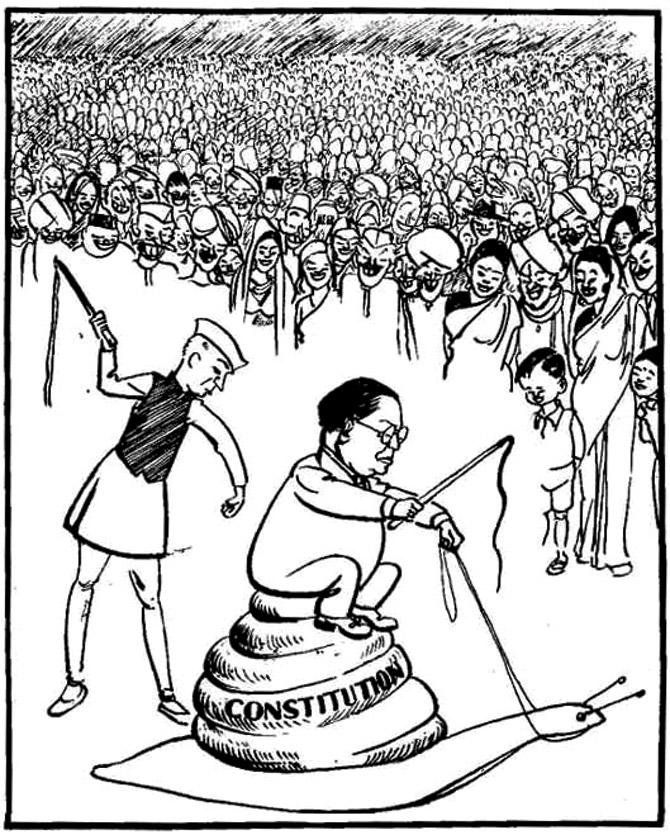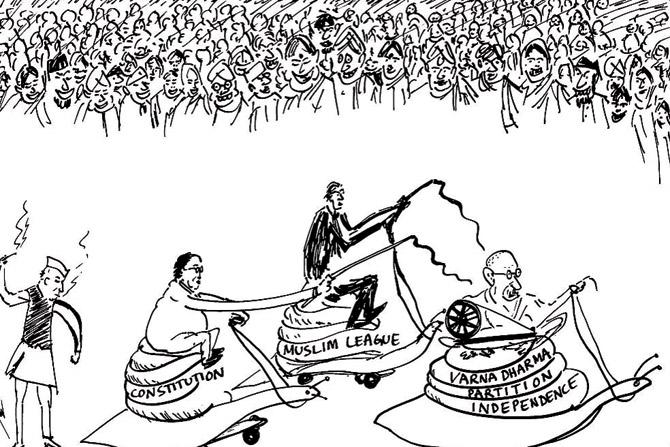Taking off from a 2012 controversy on the depiction of Ambedkar in a textbook, a scholar-cartoonist mines archives to collate 122 cartoons that chronicle the hostility he faced

When Ambedkar took it upon himself to rewrite important sections of the Hindu Code Bill, which he felt had not addressed contradictions in Hindu sociality, he paid special attention to womens rights, Divorce scare was rampant in India at the time, and Amb
The proposed Statue of Equality at Dadar-s Indu Mill compound to mark Dr BR Ambedkar-s contribution to the fight against social injustice got a 100-ft fillip this week — the bronze structure will now be taller than New York-s Statue of Liberty. This, of course, is one more addition to the countless statues of Ambedkar that dot India, depicting the architect of the Indian Constitution with his magnum opus in one hand and showing the nation the way forward with the other. We may still be far removed from the principles he strove to set Indians on the path of, but symbolism is an art we have mastered.
It-s ironic then that it was through the symbolic language of cartoons that the national leader was subjected to brazen hostility and prejudice in his time. The veneration we now associate with Ambedkar was largely posthumous; first came the barbs. The country got a glimpse of it in 2012, when the inclusion of a 1949 cartoon by K Shankar Pillai showing Jawaharlal Nehru whipping a snail-borne Ambedkar in a school textbook, evoked Dalit protest. But the debate acquired a tone of freedom of expression, and the cartoon continued to be viewed in isolation. That is, until cartoonist and researcher Unnamati Syama Sundar decided to do something about it.

The inclusion of a 1949 cartoon by Shankar showing Jawaharlal Nehru whipping a snail-borne Dr BR Ambedkar in a school textbook, evoked Dalit protest in 2012
"I had been working on colonial Indian cartoons for a long time. When the controversy erupted, I thought of delving into other cartoons on Ambedkar. While cartoon compendiums on Gandhi and Nehru have been published, there was little academic interest in Ambedkar," says Syama Sundar, who signs off as Syam. His research took him to archives across India, and each time, he would spot something intriguing — from Ambedkar being depicted as wearing the very Brahmin thread, which was a symbol of the varna system he was fighting, to a visibly shorter Ambedkar when he would be shown in the company of "tall" leaders, to far more crass portrayals —he would post them on social media. The posts generated great interest, and a book compiling these cartoons seemed like the next obvious step.

Unnamati Syama Sundar-s riposte to Shankar-s cartoon

Unnamati Syama Sundar
Syam then discussed the idea with S Anand, the director and publisher of Navayana, an independent anti-caste publishing house in New Delhi. Anand, in turn, suggested Syam to support the cartoons with research, by juxtaposing them with text that explained the historical context in which they were made. The result is No Laughing Matter: The Ambedkar Cartoons, 1932-1956, a collection of 122 cartoons from India-s leading publications, drawn by Shankar, Enver Ahmed and RK Laxman, among others. The book will be launched next week.

In pre-Independence nationalist discourse, the village became a symbol of all that was good about Indian culture. Ambedkar was opposed to this understanding. For him, the village was entrenched in Hindu law, marred with the persistence of caste and rigid structures of oppression. This 1948 cartoon by Bireshwar in National Herald shows Ambedkar wearing the Brahminical thread, casting rural poor out of the constitution
"It was deeply upsetting to see the kind of prejudice and bigotry Ambedkar had to battle. Years later, when the controversy erupted, it got tinged with the notions of artistic freedom, when the cartoons were downright offensive," shares Anand. While the text accompanying each cartoon is a lesson in the history of the making of the Republic of India, it is followed by Syam-s note, which he calls, Scratching the Surface. The note at times is steeped in satire, and makes references to contemporary incidents of violence inflicted on Dalits at others. It-s hard not to mention the recent tragic suicide of Dr Payal Tadvi in the conversation. To which, Anand says, "She made news because she died."
ON June 30, 7 pm the launch will be followed by a panel discussion
AT G5A, Mahalaxmi.
RSVP info@g5a.org
Catch up on all the latest Crime, National, International and Hatke news here. Also download the new mid-day Android and iOS apps to get latest updates
 Subscribe today by clicking the link and stay updated with the latest news!" Click here!
Subscribe today by clicking the link and stay updated with the latest news!" Click here!









